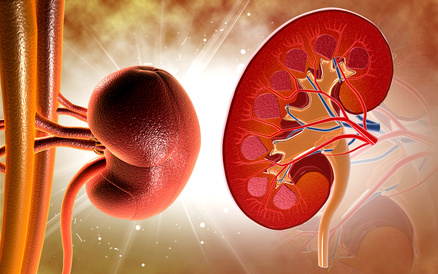EXCEL patients with chronic kidney disease and left main coronary artery disease have higher rates of acute renal failure and other events compared with the general population. However, acute renal failure was less frequent with angioplasty than with surgery, while other events such as death, stroke, or infarction at 3 years were similar for both revascularization strategies and in patients with or without chronic kidney disease.
 This study investigates the comparative effectiveness of angioplasty vs. surgery in patients with left main coronary artery disease and low or intermediate anatomical complexity according to baseline renal function values from the EXCEL (Evaluation of XIENCE Versus Coronary Artery Bypass Surgery for Effectiveness of Left Main Revascularization) trial.
This study investigates the comparative effectiveness of angioplasty vs. surgery in patients with left main coronary artery disease and low or intermediate anatomical complexity according to baseline renal function values from the EXCEL (Evaluation of XIENCE Versus Coronary Artery Bypass Surgery for Effectiveness of Left Main Revascularization) trial.
Chronic kidney disease was defined as an estimated glomerular filtration rate <60 ml/min/1.73 m² using the CKD Epidemiology Collaboration equation. Acute renal failure or new acute flare of chronic renal failure was defined as a serum creatinine increase ≥5.0 mg/dl from baseline or a new requirement for dialysis. The primary endpoint was a classic composite of death, infarction, and stroke at 3 years.
Read also: TCT 2018 | RADIOSOUND-HTN: Testing Different Renal Ablation Techniques and Devices.
Chronic kidney disease was diagnosed in 19.3% of the global study population (361 of 1869 patients). Patients with chronic kidney disease had more events at 3 years compared with patients with regular kidney function (20.8% vs. 13.5%; hazard ratio [HR]: 1.60; 95% confidence interval [CI]: 1.22 to 2.09; p = 0.0005).
Acute renal failure within 30 days from the procedure obviously occurred more commonly in patients with baseline chronic disease (5.0% vs. 0.8%; p < 0.0001), and it was strongly associated with death, infarction, or stroke at 3 years (50.7% vs. 14.4%; HR: 4.59; 95% CI: 2.73 to 7.73; p < 0.0001). Acute renal failure was less common after revascularization with angioplasty compared with surgery in patients with regular renal function (0.3% vs. 1.3%) as well as in those with baseline chronic renal insufficiency (2.3% vs. 7.7%).
Read also: Renal Impairment: How Does It Affect Angioplasty and Surgery?
There were no significant differences in the primary endpoint rates after angioplasty or surgery in patients with baseline chronic kidney disease (23.4% vs. 18.1%) as well as in those with regular renal function (13.4% vs. 13.5%; p for interaction = 0.38).
Conclusion
Patients with chronic renal insufficiency who underwent revascularization for left main coronary artery disease in the EXCEL trial had increased rates of acute renal failure and other events. Acute renal failure was less common among patients who underwent angioplasty.
Original title: Left Main Revascularization with PCI or CABG in Patients with Chronic Kidney Disease. EXCEL Trial.
Reference: Gennaro Giustino et al.
Get the latest scientific articles on interventional cardiologySubscribe to our weekly newsletter
We are interested in your opinion. Please, leave your comments, thoughts, questions, etc., below. They will be most welcome.





